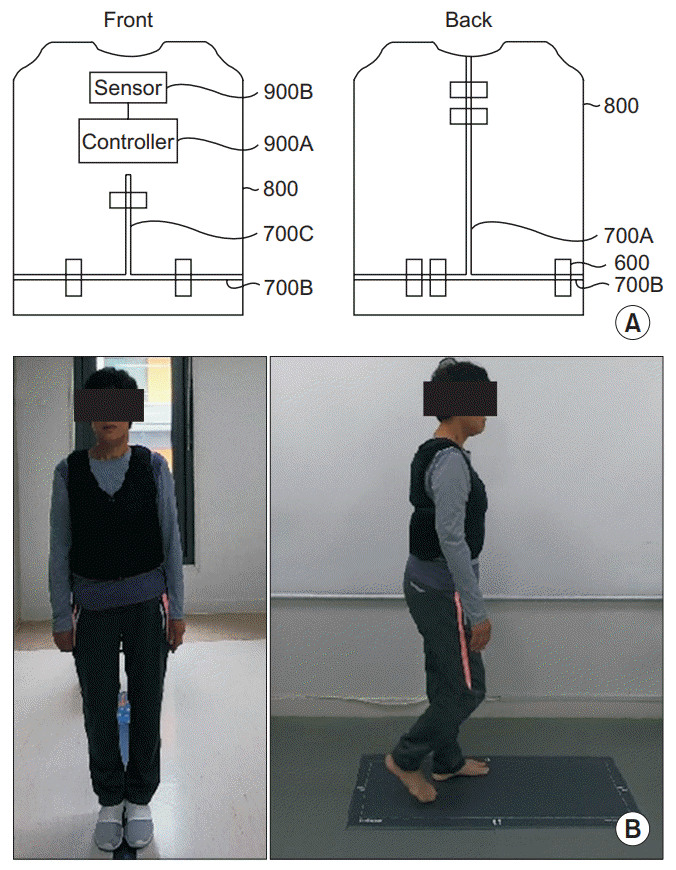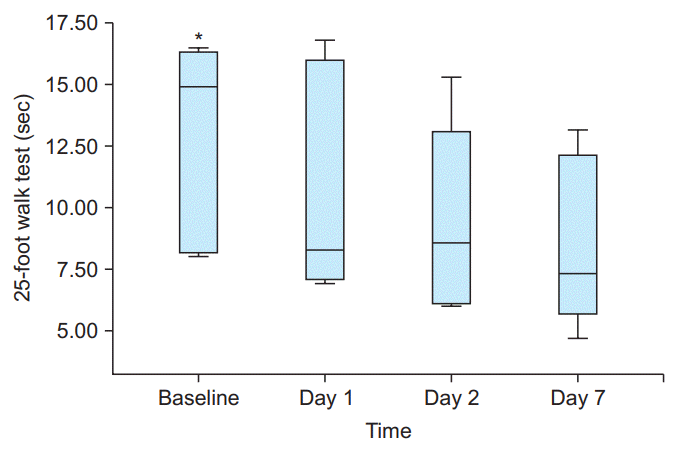1. Marquer A, Barbieri G, Perennou D. The assessment and treatment of postural disorders in cerebellar ataxia: a systematic review. Ann Phys Rehabil Med. 2014; 57:67–78.

2. Fonteyn EM, Schmitz-Hubsch T, Verstappen CC, Baliko L, Bloem BR, Boesch S, et al. Prospective analysis of falls in dominant ataxias. Eur Neurol. 2013; 69:53–7.

3. Gaxatte C, Nguyen T, Chourabi F, Salleron J, Pardessus V, Delabriere I, et al. Fear of falling as seen in the multidisciplinary falls consultation. Ann Phys Rehabil Med. 2011; 54:248–58.

4. Ioffe ME, Chernikova LA, Ustinova KI. Role of cerebellum in learning postural tasks. Cerebellum. 2007; 6:87–94.

5. Manto M. The cerebellum, cerebellar disorders, and cerebellar research: two centuries of discoveries. Cerebellum. 2008; 7:505–16.
6. Weinshenker BG, Issa M, Baskerville J. Long-term and short-term outcome of multiple sclerosis: a 3-year follow-up study. Arch Neurol. 1996; 53:353–8.
7. Rodgers MM, Mulcare JA, King DL, Mathews T, Gupta SC, Glaser RM. Gait characteristics of individuals with multiple sclerosis before and after a 6-month aerobic training program. J Rehabil Res Dev. 1999; 36:183–8.
8. Taylor NF, Dodd KJ, Prasad D, Denisenko S. Progressive resistance exercise for people with multiple sclerosis. Disabil Rehabil. 2006; 28:1119–26.

9. Gutierrez GM, Chow JW, Tillman MD, McCoy SC, Castellano V, White LJ. Resistance training improves gait kinematics in persons with multiple sclerosis. Arch Phys Med Rehabil. 2005; 86:1824–9.

10. White LJ, McCoy SC, Castellano V, Gutierrez G, Stevens JE, Walter GA, et al. Resistance training improves strength and functional capacity in persons with multiple sclerosis. Mult Scler. 2004; 10:668–74.
11. Wiles CM, Newcombe RG, Fuller KJ, Shaw S, Furnival-Doran J, Pickersgill TP, et al. Controlled randomised crossover trial of the effects of physiotherapy on mobility in chronic multiple sclerosis. J Neurol Neurosurg Psychiatry. 2001; 70:174–9.

12. Lord SE, Wade DT, Halligan PW. A comparison of two physiotherapy treatment approaches to improve walking in multiple sclerosis: a pilot randomized controlled study. Clin Rehabil. 1998; 12:477–86.

13. Smedal T, Lygren H, Myhr KM, Moe-Nilssen R, Gjelsvik B, Gjelsvik O, et al. Balance and gait improved in patients with MS after physiotherapy based on the Bobath concept. Physiother Res Int. 2006; 11:104–16.

14. Chase RA, Cullen JK Jr, Sullivan SA, Ommaya AK. Modification of intention tremor in man. Nature. 1965; 206:485–7.

15. Hewer RL, Cooper R, Morgan MH. An investigation into the value of treating intention tremor by weighting the affected limb. Brain. 1972; 95:579–90.

16. Morgan MH, Hewer RL, Cooper R. Application of an objective method of assessing intention tremor: a further study on the use of weights to reduce intention tremor. J Neurol Neurosurg Psychiatry. 1975; 38:259–64.
17. Morgan MH. Ataxia and weights. Physiotherapy. 1975; 61:332–4.
18. Clopton N, Schultz D, Boren C, Porter J, Brillbart T. Effects of axial weight loading on gait for subjects with cerebellar ataxia: preliminary findings. Neurol Rep. 2003; 27:15–21.
19. Lucy SD, Hayes KC. Postural sway profiles: normal subjects and subjects with cerebellar ataxia. Physiother Can. 1985; 37:140–8.
20. Crittendon A, O’Neill D, Widener GL, Allen DD. Standing data disproves biomechanical mechanism for balance-based torso-weighting. Arch Phys Med Rehabil. 2014; 95:43–9.

21. Widener GL, Allen DD, Gibson-Horn C. Randomized clinical trial of balance-based torso weighting for improving upright mobility in people with multiple sclerosis. Neurorehabil Neural Repair. 2009; 23:784–91.

22. Hunt CM, Widener G, Allen DD. Variability in postural control with and without balance-based torsoweighting in people with multiple sclerosis and healthy controls. Phys Ther. 2014; 94:1489–98.
23. Holmes G. The cerebellum of man. Brain. 1939; 62:1–30.

24. Widener GL, Allen DD, Gibson-Horn C. Balancebased torso-weighting may enhance balance in persons with multiple sclerosis: preliminary evidence. Arch Phys Med Rehabil. 2009; 90:602–9.

25. Goff B. The application of recent advances in neurophysiology to Miss M. Rood’s concept of neuromuscular facilitation. Physiotherapy. 1972; 58:409–15.








 PDF
PDF Citation
Citation Print
Print



 XML Download
XML Download